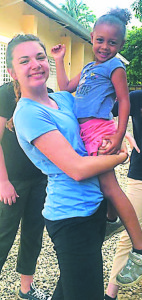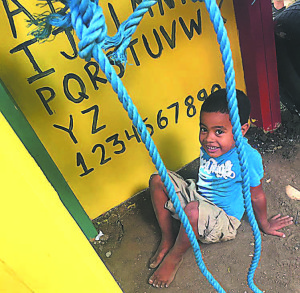“Life-changing.”
That’s how Oxford Village resident Tate Hamilton, 15, described the two weeks she recently spent in the Dominican Republic helping people of all ages improve their health and quality of life.
“It’s something I’ll always remember,” she said.
Hamilton, who will be starting her sophomore year at Oxford High School this fall, expanded her horizons by venturing to the Caribbean nation as part of a program through Global Leadership Adventures (GLA).
According to the website www.experiencegla.com, GLA operates summer volunteer programs for high school students in authentic, non-tourist communities around the world. Programs are available involving children, conservation, sports, languages and much more.

During her time in the Dominican Republic, which makes up two-thirds of the island of Hispaniola, Hamilton saw and did a lot as part of a global health initiative.
In Las Canas, she was part of a health fair that taught children how to brush their teeth, wash their hands and live a healthier lifestyle.
Hamilton noted obesity is a “huge” health issue in the Dominican Republic.
“They don’t have enough money to buy proper foods,” she said. “They’re just buying whatever’s cheapest and that’s probably the worst food for them.”
She said the Dominicans eat a lot of “junk food,” such as cakes, chips and candies, because they don’t have access to fruits and vegetables.
Upper respiratory infections are another problem that plague the Dominican population, according to Hamilton, because their houses are typically small and poorly ventilated, so they breathe in much of the indoor air pollution caused by the fuel their cookstoves burn.
In Las Brazos, Hamilton helped build a school playground for K-5 students, so they can have fun and be more physically active. “They loved it,” she said.
Hamilton tried her hand at construction by insulating a Las Canas man’s house with plastic pop bottles.
“They have a lot of trash there, especially bottles because they drink a lot of soda,” she said.
The house’s walls were packed with layers of empty bottles, which were then covered by chicken wire and cement. It doesn’t sound like much, but, according to Hamilton, it really works.
“It makes (the temperature inside the house) like 5 degrees cooler than outside,” she said.
Hamilton noted the house was “probably as big as my kitchen.”
The experience that made the biggest impression on her was visiting a place called La Grua, which is a batey consisting of a mix of Dominican and Haitian peoples.
Originally created in the first half of the 20th century by the thriving sugar industry, bateyes are essentially shanty towns that were made to house migrant workers from neighboring Haiti, which makes up the other third of Hispaniola.
Today, most batey residents are extremely poor and have few options for improving their standard of living. Large families living in tiny hovels with little or no access to electricity, running water and sanitation services are the norm in these bleak, impoverished areas.
It was in La Grua that Hamilton learned about the discrimination Haitians face on a daily basis. They’re looked down upon by the Dominicans and as a result, the Haitians live in squalor by comparison.
“It’s very obvious,” Hamilton said. “Haitian people are treated terribly. They live in dirt-poor communities.”
“I didn’t realize how alive racism is, especially in other countries,” she noted.
While visiting La Grua, Hamilton had the opportunity to play with some Haitian children and she loved every minute of it.
“When the bus rolls up, they just latch onto you because they just want someone to play with,” she said.
Hamilton recalled when she visited the batey, she picked up a 3-year-old boy named Sam. He put his little head on her shoulder and slept for two hours.
Interacting with the kids, be they Haitian or Dominican, was Hamilton’s favorite part of her experience.
“They’re so nice and they’re so friendly,” she said. “All they want to do is hold your hand and play with you. It doesn’t matter who you are, they just want to have fun.”

Overall, Hamilton found the people of the Dominican Republic to be very friendly – more so than many folks in the United States.
“Socially, people are much more welcoming there,” she said. “Everyone’s so nice and says, ‘Hola! Como esta?’ It’s kind of like a huge family. Here, people don’t just randomly say ‘hi’ to people. It’s much different.”
Witnessing the poverty in the Dominican Republic made Hamilton much more conscious about how she spends her money at home because a little amount here can make a big difference in someone’s life elsewhere in the world.
“Ten dollars can give someone a water filter to have clean drinking water,” she said.
It appears Hamilton’s trip to the Dominican Republic wasn’t a onetime thing. “I want to go back,” she said. “I’m already planning to start another project.”
She wants to be part of efforts to improve the air-quality in Dominican homes by replacing their current cookstoves with cleaner, more eco-friendly versions.
Hamilton encourages other high school students to take trips like hers and help make the world a better place.
She said visiting other countries, meeting new people and seeing their problems firsthand provides a much different perspective than just watching it on television.
“It was honestly the best time of my life,” she said. “I think everyone should do that.”

Leave a Reply